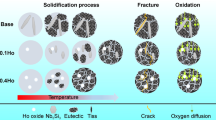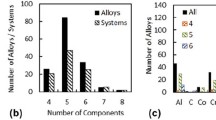Abstract
Enhanced oxidation resistance is a primary demand for the application of refractory high-entropy alloys (RHEAs) at elevated temperatures. In this study, Al was added to a Ti2VZrNb RHEA to partially substitute Nb to improve its oxidation resistance and mechanical properties. The alloy was found to have an increased oxidation resistance by forming a continuous Al2O3 + ZrO2 oxide protective surface. At the same time, the room-temperature yield strength was also increased by 66% to 1273 MPa via solid solution strengthening. The low atomic mass of Al also helped to reduce the density of the alloy by 8.2% to 5.44 g cm−3. This resulted in a high specific yield strength of 234 MPa cm3 g−1 for the alloy. Meanwhile, the Ti2VZrNb0.5Al0.5 alloy also exhibited a high compressive plasticity of >50%. These values are among the best reported so far for RHEAs.

摘要
提高抗氧化性能是难熔高熵合金高温应用的首要要求. 本研究中, 我们将Al代替50%Nb添加到Ti2VZrNb难熔高熵合金中, 以提高其抗氧化性能与力学性能. 结果表明, 相比于Ti2VZrNb合金, Ti2VZrNb0.5-Al0.5 合金的抗氧化性得到了显著提升, 这是由于在合金表面形成了连续的Al2O3 + ZrO2氧化层保护膜. 同时, Ti2VZrNb0.5Al0.5 合金室温屈服强度高达1273 MPa, 相比于Ti2VZrNb合金强度提升66%. 结构表征说明, Ti2VZrNb0.5Al0.5合金强度提升得益于其较大的固溶强化效果. 较轻元素Al的添加使得该合金具有较低的密度(5.44 g cm−3), 相比于Ti2VZrNb 合金密度降低8.2%, 这使得该合金的比强度高达234 MPa cm3g−1. 同时, Ti2VZrNb0.5Al0.5合金也具有较高的压缩塑性(>50%). 综合这些结果, 该合金是迄今为止所报道的性能最好的难熔高熵合金.
Similar content being viewed by others
References
Senkov ON, Scott JM, Senkova SV, et al. Microstructure and room temperature properties of a high-entropy TaNbHfZrTi alloy. J Alloys Compd, 2011, 509: 6043–6048
Srikanth M, Annamalai AR, Muthuchamy A, et al. A review of the latest developments in the field of refractory high-entropy alloys. Crystals, 2021, 11: 612
Miracle DB, Senkov ON. A critical review of high entropy alloys and related concepts. Acta Mater, 2017, 122: 448–511
Senkov O, Isheim D, Seidman D, et al. Development of a refractory high entropy superalloy. Entropy, 2016, 18: 102
Senkov ON, Wilks GB, Scott JM, et al. Mechanical properties of Nb25Mo25Ta25W25 and V20Nb20Mo20Ta20W20 refractory high entropy alloys. Intermetallics, 2011, 19: 698–706
Fecht H, Furrer D. Processing of nickel-base superalloys for turbine engine disc applications. Adv Eng Mater, 2000, 2: 777–787
Auburtin P, Wang T, Cockcroft SL, et al. Freckle formation and freckle criterion in superalloy castings. Metall Materi Trans B, 2000, 31: 801–811
Caron P, Khan T. Evolution of Ni-based superalloys for single crystal gas turbine blade applications. Aerospace Sci Tech, 1999, 3: 513–523
Gell M, Duhl DN, Giamei AF. The development of single crystal superalloy turbine blades. Superalloys, 1980: 205–214
Senkov ON, Woodward CF. Microstructure and properties of a refractory NbCrMo0.5Ta0.5TiZr alloy. Mater Sci Eng-A, 2011, 529: 311–320
Senkov ON, Woodward C, Miracle DB. Microstructure and properties of aluminum-containing refractory high-entropy alloys. JOM, 2014, 66: 2030–2042
Senkov ON, Senkova SV, Woodward C. Effect of aluminum on the microstructure and properties of two refractory high-entropy alloys. Acta Mater, 2014, 68: 214–228
Senkov ON, Jensen JK, Pilchak AL, et al. Compositional variation effects on the microstructure and properties of a refractory high-entropy superalloy AlMo0.5NbTa0.5TiZr. Mater Des, 2018, 139: 498–511
Yao HW, Qiao JW, Gao MC, et al. NbTaV-(Ti,W) refractory high-entropy alloys: Experiments and modeling. Mater Sci Eng-A, 2016, 674: 203–211
Wang SP, Xu J. TiZrNbTaMo high-entropy alloy designed for orthopedic implants: As-cast microstructure and mechanical properties. Mater Sci Eng-C, 2017, 73: 80–89
Su L, Jia L, Weng J, et al. Improvement in the oxidation resistance of Nb-Ti-Si-Cr-Al-Hf alloys containing alloyed Ge and B. Corrosion Sci, 2014, 88: 460–465
Chang CH, Titus MS, Yeh JW. Oxidation behavior between 700 and 1300 °C of refractory TiZrNbHfTa high-entropy alloys containing aluminum. Adv Eng Mater, 2018, 20: 1700948
Butler TM, Chaput KJ, Dietrich JR, et al. High temperature oxidation behaviors of equimolar NbTiZrV and NbTiZrCr refractory complex concentrated alloys (RCCAs). J Alloys Compd, 2017, 729: 1004–1019
Liu XW, Bai ZC, Ding XF, et al. A novel light-weight refractory high-entropy alloy with high specific strength and intrinsic deformability. Mater Lett, 2021, 287: 129255
Liao YC, Li TH, Tsai PH, et al. Designing novel lightweight, high-strength and high-plasticity Ti(AlCrNb)100-medium-entropy alloys. Intermetallics, 2020, 117: 106673
Xu ZQ, Ma ZL, Wang M, et al. Design of novel low-density refractory high entropy alloys for high-temperature applications. Mater Sci Eng-A, 2019, 755: 318–322
Yurchenko NY, Stepanov ND, Shaysultanov DG, et al. Effect of Al content on structure and mechanical properties of the ALCrNbTiVZr (x = 0; 0.25; 0.5; 1) high-entropy alloys. Mater Charact, 2016, 121: 125–134
Daoud HM, Manzoni AM, Völkl R, et al. Oxidation behavior of Al8Co17Cr17Cu8Fe17Ni33, Al23Co15Cr23Cu8Fe15Ni15, and Al17Co17Cr17-Cu17Fe17Ni17 compositionally complex alloys (high-entropy alloys) at elevated temperatures in air. Adv Eng Mater, 2015, 17: 1134–1141
Li LC, Li MX, Liu M, et al. Enhanced oxidation resistance of MoTa-TiCrAl high entropy alloys by removal of Al. Sci China Mater, 2021, 64: 223–231
Guo S, Hu Q, Ng C, et al. More than entropy in high-entropy alloys: Forming solid solutions or amorphous phase. Intermetallics, 2013, 41: 96–103
Guo S, Liu CT. Phase stability in high entropy alloys: Formation of solid-solution phase or amorphous phase. Prog Nat Sci-Mater Int, 2011, 21: 433–446
Ma Y, Wang Q, Jiang BB, et al. Controlled formation of coherent cuboidal nanoprecipitates in body-centered cubic high-entropy alloys based on Al2(Ni,Co,Fe,Cr)14 compositions. Acta Mater, 2018, 147: 213–225
Ge S, Fu H, Zhang L, et al. Effects of Al addition on the microstructures and properties of MoNbTaTiV refractory high entropy alloy. Mater Sci Eng-A, 2020, 784: 139275
Nagasako N, Jahnátek M, Asahi R, et al. Anomalies in the response of V, Nb, and Ta to tensile and shear loading: Ab initio density functional theory calculations. Phys Rev B, 2010, 81: 094108
Sheikh S, Shafeie S, Hu Q, et al. Alloy design for intrinsically ductile refractory high-entropy alloys. J Appl Phys, 2016, 120: 164902
Guo S, Ng C, Lu J, et al. Effect of valence electron concentration on stability of fcc or bcc phase in high entropy alloys. J Appl Phys, 2011, 109: 103505
Qi L, Chrzan DC. Tuning ideal tensile strengths and intrinsic ductility of bcc refractory alloys. Phys Rev Lett, 2014, 112: 115503
Zhang Y, Zhou Y, Lin J, et al. Solid-solution phase formation rules for multi-component alloys. Adv Eng Mater, 2008, 10: 534–538
Zhang Y, Guo S, Liu CT, et al. Phase formation rules. In: Gao M, Yeh JW, Liaw P, et al. (eds.). High-Entropy Alloys. Cham: Springer, 2016. 21–49
Saunders N, Miodownik AP, Schillé JP. Modelling of the thermophysical and physical properties for solidification of Ni-based superalloys. J Mater Sci, 2004, 39: 7237–7243
Saunders N, Guo UKZ, Li X, et al. Using JMatPro to model materials properties and behavior. JOM, 2003, 55: 60–65
Gludovatz B, Hohenwarter A, Catoor D, et al. A fracture-resistant high-entropy alloy for cryogenic applications. Science, 2014, 345: 1153–1158
Feng R, Gao M, Lee C, et al. Design of light-weight high-entropy alloys. Entropy, 2016, 18: 333
Senkov ON, Senkova SV, Woodward C, et al. Low-density, refractory multi-principal element alloys of the Cr-Nb-Ti-V-Zr system: Microstructure and phase analysis. Acta Mater, 2013, 61: 1545–1557
Senkov ON, Miracle DB, Chaput KJ, et al. Development and exploration of refractory high entropy alloys—A review. J Mater Res, 2018, 33: 3092–3128
Stepanov ND, Yurchenko NY, Skibin DV, et al. Structure and mechanical properties of the AlCrxNbTiV (x = 0, 0.5, 1, 1.5) high entropy alloys. J Alloys Compd, 2015, 652: 266–280
Chen H, Kauffmann A, Gorr B, et al. Microstructure and mechanical properties at elevated temperatures of a new Al-containing refractory high-entropy alloy Nb-Mo-Cr-Ti-Al. J Alloys Compd, 2016, 661: 206–215
Yurchenko NY, Stepanov ND, Zherebtsov SV, et al. Structure and mechanical properties of B2 ordered refractory AlNbTiVZrx (x= 0–1.5) high-entropy alloys. Mater Sci Eng-A, 2017, 704: 82–90
Chen S, Yang X, Dahmen K, et al. Microstructures and crackling noise of AlxNbTiMoV high entropy alloys. Entropy, 2014, 16: 870–884
Guo NN, Wang L, Luo LS, et al. Microstructure and mechanical properties of in-situ MC-carbide particulates-reinforced refractory high-entropy Mo0.5NbHf0.5ZrTi matrix alloy composite. Intermetallics, 2016, 69: 74–77
Zhang Y, Yang X, Liaw PK Alloy design and properties optimization of high-entropy alloys JOM, 2012, 64: 830–838
Liu Y, Zhang Y, Zhang H, et al. Microstructure and mechanical properties of refractory HfMo0.5NbTiV0.5Six high-entropy composites. J Alloys Compd, 2017, 694: 869–876
Juan CC, Tseng KK, Hsu WL, et al. Solution strengthening of ductile refractory HfMxNbTaTiZr high-entropy alloys. Mater Lett, 2016, 175: 284–287
Han ZD, Luan HW, Liu X, et al. Microstructures and mechanical properties of Ti NbMoTaW refractory high-entropy alloys. Mater Sci Eng-A, 2018, 712: 380–385
Senkov ON, Senkova SV, Miracle DB, et al. Mechanical properties of low-density, refractory multi-principal element alloys of the Cr-Nb-Ti-V-Zr system. Mater Sci Eng-A, 2013, 565: 51–62
Qiao DX, Jiang H, Chang XX, et al. Microstructure and mechanical properties of VTaTiMoAlx refractory high entropy alloys. Mater Sci Forum, 2017, 898: 638–642
Yang X, Zhang Y, Liaw PK. Microstructure and compressive properties of NbTiVTaAlx high entropy alloys. Procedia Eng, 2012, 36: 292–298
Cao P, Ni X, Tian F, et al. Ab initio study of AlxMoNbTiV high-entropy alloys. J Phys-Condens Matter, 2015, 27: 075401
Liu CM, Wang HM, Zhang SQ, et al. Microstructure and oxidation behavior of new refractory high entropy alloys. J Alloys Compd, 2014, 583: 162–169
Yurchenko N, Panina E, Zherebtsov S, et al. Oxidation behavior of refractory AlNbTiVZr0.25 high-entropy alloy. Materials, 2018, 11: 2526
Gorr B, Schellert S, Müller F, et al. Current status of research on the oxidation behavior of refractory high entropy alloys. Adv Eng Mater, 2021, 23: 2001047
Anne BR, Shaik S, Tanaka M, et al. A crucial review on recent updates of oxidation behavior in high entropy alloys. SN Appl Sci, 2021, 3: 366
Acknowledgements
This research was supported by the National Key R&D Program of China (2021YFA1200201), the National Natural Science Foundation of China (52071003, 91860202, and 11604006), Beijing Nova Program (Z211100002121170), Beijing Municipal Education Commission Project (PXM2020_012040_002021 and PXM2019_012045_003232), Beijing Outstanding Young Scientists Projects (BJJWZYJH01201910005018), Beijing Natural Science Foundation (Z180014), and “111” project (DB18015).
Author information
Authors and Affiliations
Contributions
Han X, Mao S, and An Z designed the study. An Z, Yang T, Yang X, Wang X, and Liu S carried out the main experiments. An Z, Han X, Mao S, Zhang Z, Liu Y, and Chen Y analyzed the data and wrote the main draft of the paper. All authors contributed to the discussion of the results and commented on the manuscript.
Corresponding authors
Additional information
Conflict of interest
The authors declare that they have no conflict of interest.
Supplementary information
Supporting data are available in the online version of the paper.
Zibing An is a PhD candidate at Beijing Key Laboratory and the Institute of Microstructure and Properties of Advanced Materials, Beijing University of Technology. His current research focuses on the design and deformation mechanism of high-performance high-entropy alloy materials.
Shengcheng Mao is a professor at Beijing University of Technology. His current interests focus on the development of novel in-situ techniques in TEM and their applications in high-entropy alloys and superalloys, to in-situ study the evolution of microstructure under external mechanical, electric and thermal fields, and to reveal the underlying mechanisms.
Yinong Liu is a professor at The University of Western. His current research interests are in the broad field of materials science and engineering, with specific attention in physical metallurgy, metallic composites, shape memory alloys, magnetic materials, thin films for MEMS technology, elastic strain engineering, nanomaterials, and functional materials.
Xiaodong Han is a professor at Beijing University of Technology. He originally developed the atomic-level in-situ dynamic characterization method of the mechanical behavior of materials, and increased the spatial resolution of the in-situ characterization technology of the mechanical behavior of materials from nanometer to picometer scales, achieving an order of magnitude improvement. His research mainly focuses on the physical and chemical properties of materials, the mechanical behavior of materials from micro-nano to atomic resolution in a wide temperature range (room temperature to 1200°C) and environmental conditions.
Supplementary Materials
40843_2022_2045_MOESM1_ESM.pdf
Simultaneously enhanced oxidation resistance and mechanical properties in a novel lightweight Ti2VZrNb0.5Al0.5 high-entropy alloy
Rights and permissions
About this article
Cite this article
An, Z., Mao, S., Yang, T. et al. Simultaneously enhanced oxidation resistance and mechanical properties in a novel lightweight Ti2VZrNb0.5Al0.5 high-entropy alloy. Sci. China Mater. 65, 2842–2849 (2022). https://doi.org/10.1007/s40843-022-2045-4
Received:
Accepted:
Published:
Issue Date:
DOI: https://doi.org/10.1007/s40843-022-2045-4




